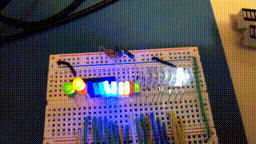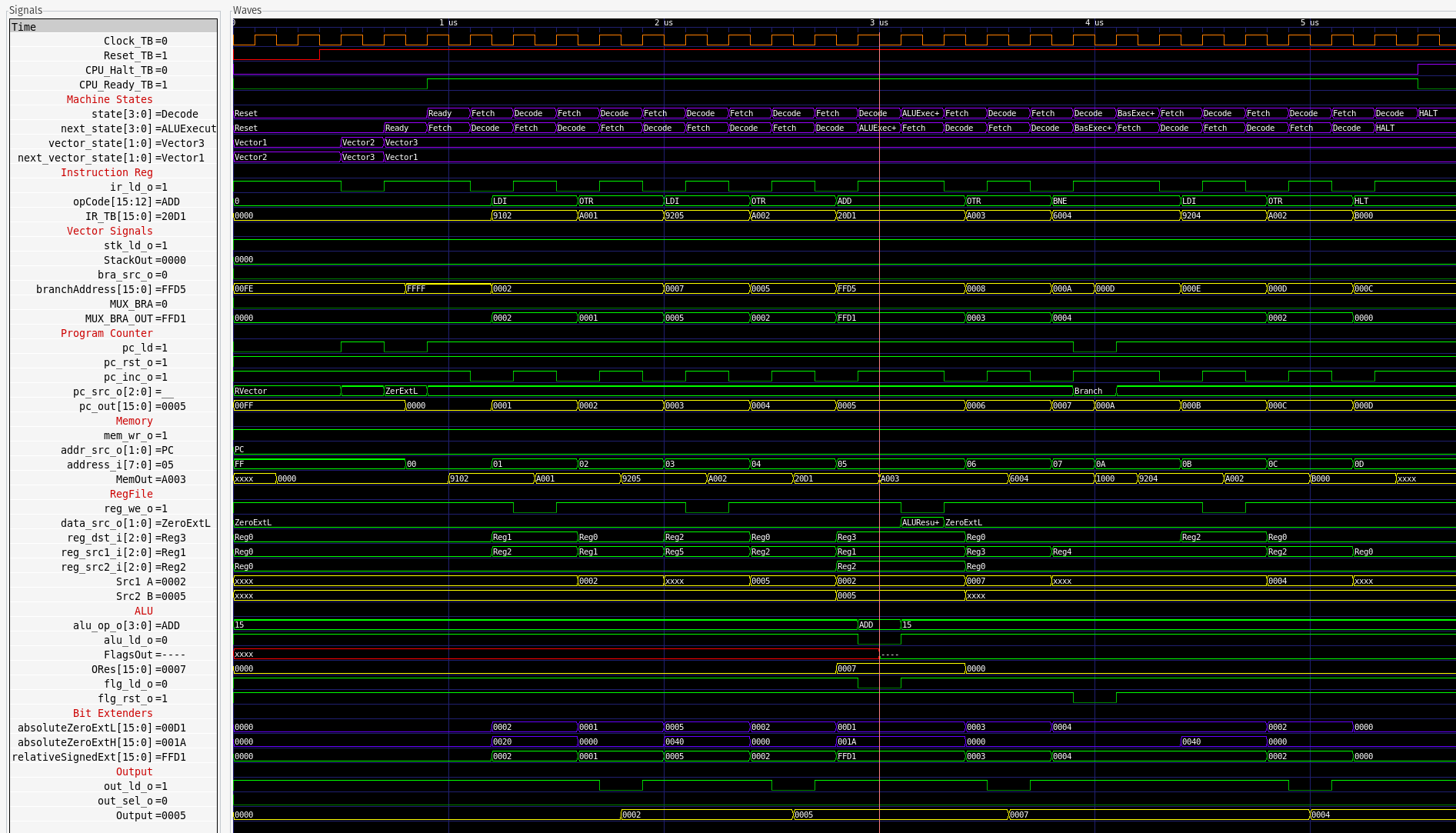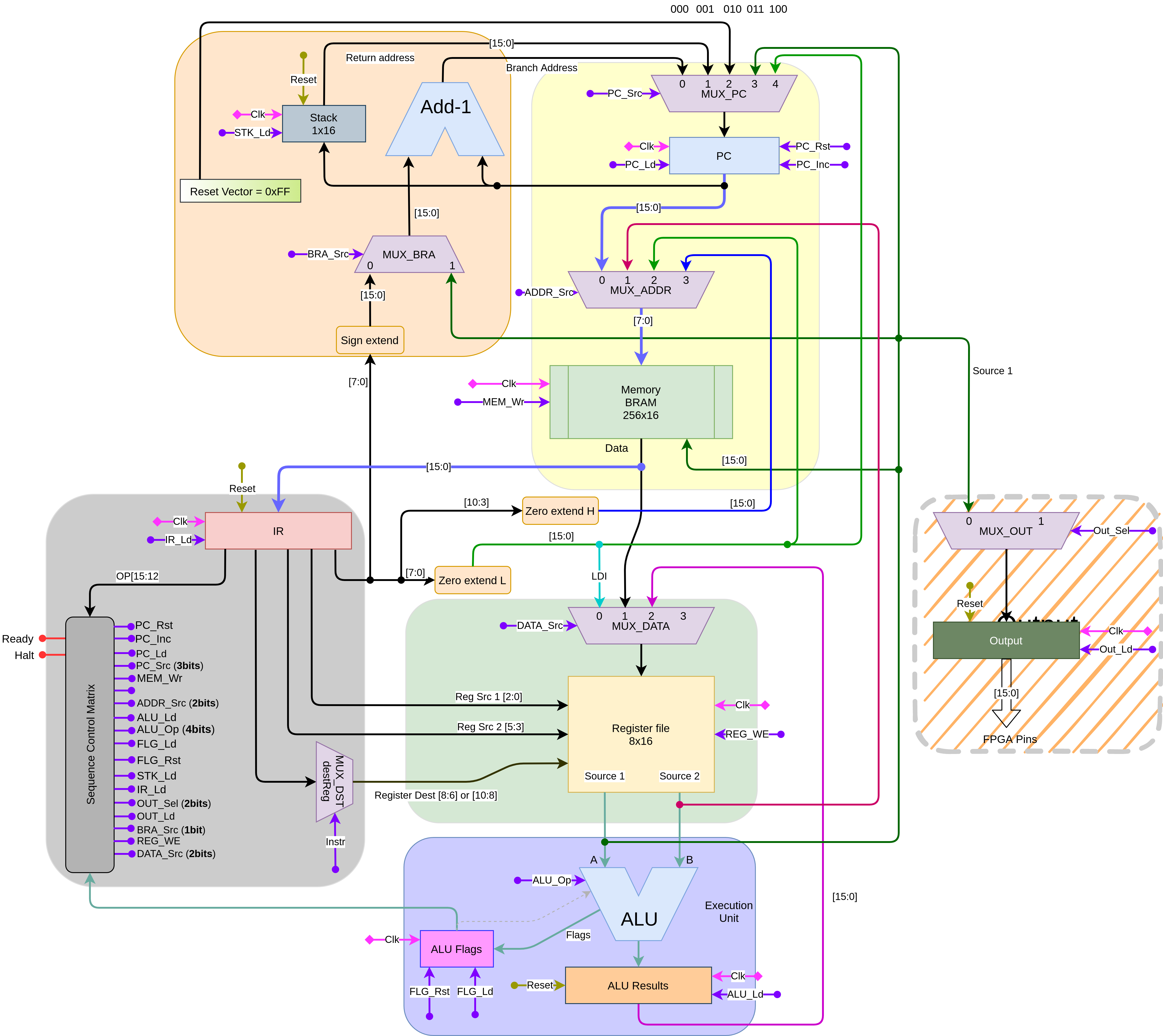An FPGA softcore processor for a corresponding video series on my After Hours Engineering Youtube channel:
A09 is a simplified 16bit CPU for learning purposes.
made using drawio
All modules that make up the CPU are in the /Processor/Modules folder, except for two files:
- mealy.v
- sequence_control_7c.v
These two files are specific to parts of the video series.
All module simulations are in the Simulation folder. The cpu folder has extra ".txt" files for translating numbers to labels within Gtkwave.
Here is an example of the BNE instruction during simulation with iverilog:
Any Modules that were synthesized were tested and uploaded to just the TinyFPGAB2. The main CPU softcore was synthesized only on the BlackiceMx.
The roms/readme.md file contains hand crafted assembly and machine code. The "Adr Hex" columns were copied into their respective *.dat file. It is the *.dat file that is embedded into the FPGA BRAM.
https://www.chipverify.com/verilog/verilog-timing-control
The ROM portion of memory needs to initialized in the memory.v initial block, for example:
`define ROM_CONTENTS "../../roms/Count_Out.dat"
...
// memory.v
initial begin
$readmemh (`ROM_CONTENTS, mem); // , 0, 6
...
end
...
You can initialize memory outside of memory.v only in simulation mode. Synthization requires initialization only within the memory module.
https://ask.csdn.net/questions/1800353
See this response below, but it basically says:
When you do ./yosys -f "verilog -sv" file.v you are implicitly doing a read_verilog file.v. What read_verilog does is it both analyses (i.e. builds the AST) and elaborates (i.e. converts into RTLIL) the design. Since there is no concept of hierarchy at this step, it elaborates each module in the design as if it was a top module, using default parameter values. It's this step that causes a warning.
$ ./yosys -q -f "verilog -sv" bug2039.v
bug2039.v:26: Warning: Range select out of bounds on signal `\o_result': Setting result bit to undef.
If you want to suppress this behaviour, you will need to add the -defer option and set the top explicitly:
$ ./yosys -q -f "verilog -sv -defer" bug2039.v -p "synth_ice40 -top ALU_Test_Top"
What this does is to defer the elaboration step to the hierarchy pass. Since nothing has been elaborated into RTLIL, hierarchy is currently unable to auto-detect the top-level (as it can't currently examine the AST) and so you have to set it manually.
Info: Annotating ports with timing budgets for target frequency 12.00 MHz
Info: remaining fanin includes O (net ControlMatrix.alu_instr) <----- <--- This is the issue
Info: driver = $abc$2502$auto$blifparse.cc:492:parse_blif$2513_LC.O |
Info: user: $abc$2502$auto$blifparse.cc:492:parse_blif$2511_LC.I3 | <------------------------
Info: user: $abc$2502$auto$blifparse.cc:492:parse_blif$2513_LC.I1 |
Info: user: $abc$2502$auto$blifparse.cc:492:parse_blif$2526_LC.I1 | Keep traveling upward
Info: remaining fanin includes O (net $abc$2502$techmap\ControlMatrix.$auto$rt... |
Info: driver = $abc$2502$auto$blifparse.cc:492:parse_blif$2511_LC.O <--.----->----------------------|
Info: user: $abc$2502$auto$blifparse.cc:492:parse_blif$2509_LC.I1 |
Info: user: $abc$2502$auto$blifparse.cc:492:parse_blif$2523_LC.I3 --> <----------------------------
Info: remaining fanin includes O (net $abc$2502$techmap$techmap\ControlMatrix... |
Info: driver = $abc$2502$auto$blifparse.cc:492:parse_blif$2526_LC.O |
Info: user: $abc$2502$auto$blifparse.cc:492:parse_blif$2525_LC.I1 |
Info: remaining fanin includes O (net pin8$SB_IO_OUT) |
Info: driver = $abc$2502$auto$blifparse.cc:492:parse_blif$2525_LC.O |
Info: user: pin8$sb_io.D_OUT_0 | Travel upwards
Info: remaining fanin includes O (net pin17_ss$SB_IO_OUT) |
Info: driver = $abc$2502$auto$blifparse.cc:492:parse_blif$2509_LC.O |
Info: user: $abc$2502$auto$blifparse.cc:492:parse_blif$2513_LC.I2 |
Info: user: $abc$2502$auto$blifparse.cc:492:parse_blif$2521_LC.I0 |
Info: user: $abc$2502$auto$blifparse.cc:492:parse_blif$2524_LC.I2 |
Info: user: pin17_ss$sb_io.D_OUT_0 |
Info: remaining fanin includes O (net $abc$2502$techmap\ControlMatrix.$4\next_state[2:0][1]_new_inv_) |
Info: driver = $abc$2502$auto$blifparse.cc:492:parse_blif$2523_LC.O >----------------------- Start here "A"
Info: user: $abc$2502$auto$blifparse.cc:492:parse_blif$2522_LC.I0
ERROR: timing analysis failed due to presence of combinatorial loops, incomplete specification of timing ports, etc.
0 warnings, 1 error
When nextpnr detects a loop it stops immediately with an ERROR. Generally the last fanin being processed is hierarchically related to the actual cause.
In the case above we start searching based on the last fanin's driver (aka 2523_LC.O). Searching on 2523_LC.O yields a user higher up the hierarchy 2523_LC.I3. Searching on this user's driver leeds to 2511_LC.I3 which leads to the top-most driver that is associated with the top-most fanin: net ControlMatrix.alu_instr. This is caused by the fact that there is a path that results in no value being assigned to the alu_instr signal. The fix is to make sure all signals within behavioural blocks have assignments. Below the fix is to add the missing assignment just before the case(...) statement:
From this:
always @* begin
...
src1_sel = 1'b1; // Route Src1-IR to Reg-file Src1
data_src = 2'b00; // Select Zero extended source
...
case (state)
...
endcase
To:
always @* begin
...
src1_sel = 1'b1; // Route Src1-IR to Reg-file Src1
data_src = 2'b00; // Select Zero extended source
alu_instr = 1'b0; // Default Complete ALU instruction <-- This was missing!!!
...
case (state)
...
endcase
Thus Combination-loops are most often caused when left-hand signals are not being Set within a behavioural block. For example:
always @*
case (s[3:1])
3'b001: late = 1'b1;
3'b100: early = 1'b1;
default: begin
early = 1'b0;
late = 1'b0;
end
endcase
When s[3:1] is 3'b001 or 3'b100, either late or early is set but NOT the other, the other value remains at its previous value. This will result in an inferred latch. As the iCE40 doesn't have latch primitives, Yosys has to implement this as a combinational loop--which is an error.
It appears that connecting the ground of the TTGO to the FPGA causes trouble loading the FPGA. Just leave them separate.
74LS02 using a resister divider network
Picking R1 = 10kOhm and R2 = 20kOhm
See TTGO-Espressif-Projects/Verilog-Projects/A09 : https://github.com/wdevore/TTGO-Espressif-Projects/tree/main/a09_control



